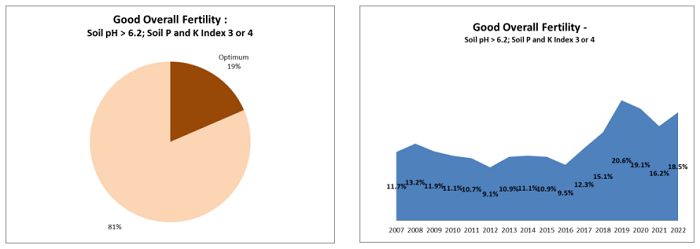03 February 2023
Caution advised as soil fertility levels remain stable in 2022

A recent review of the 2022 soil test results show that for the second year running the number of soil samples taken across Ireland has increased. The largest increase in soil sample numbers was on drystock farms, which increased by 19% in 2022.
Overall soil fertility showed some positive trends, with a stabilisation in proportion of soils with an overall optimum soil fertility for pH, phosphorous (P) and potassium (K) on both drystock and tillage farms, while improvement in soil fertility was shown on dairy farms in 2022. This follows two years of decline in optimum levels of soil fertility on grassland farms.
All farm types showed an improvement in soil P and K fertility, with the exception of tillage farms where soil K levels declined slightly for the first time in 11 years. The soil samples from dairy farms indicate a 4% increase in soils with optimum soil fertility to 20% in total. Soil with optimum fertility on tillage farms increased slightly to 19% currently, while soil fertility remained unchanged on drystock farms at just 13% within the optimum range for pH, P and K.
Figure 1: Good overall fertility trends

Mark Plunkett, Soil and Plant Nutrition Specialist at Teagasc, said: “With 39 to 57% of our soils requiring lime application, it is now a priority on grassland and tillage farms to apply lime based on soil analysis to optimise soil pH. At a time of large reductions (-25%) in the applications of both P and K fertilisers, lime now has a major role to play in regulating the supply of soil N, P and K and the efficient use of applied nutrients in the form of cattle slurry and chemical fertilisers.”
Soil pH levels have remained relatively unchanged, but a large deficit in lime application on grassland farms remains. The soil test results show that 47% of dairy farm samples and 57% drystock farm samples have pH levels below the target pH of greater than 6.3. On tillage farms, overall soil pH levels are higher, yet 39% of soils still remain below the target soil pH of greater than 6.5. Early indications suggest that lime use in 2022 will exceed one million tonnes for the second year in a row. These lime applications will reduce the levels of soil acidity in the years ahead, but further correction of soil pH on farms will be critical to increase fertiliser use efficiency, especially where fertiliser P and K use has been reduced due to increasing cost of fertiliser in recent years.
Figure 2: Soil pH trends

Dr. David Wall, Soil Fertility Researcher at Teagasc, Johnstown Castle said: “These soil test results indicate that national soil fertility levels have broadly held stable, however, we must be conscious of what has happened with fertiliser use on farms over the past year. Unfortunately, if reduced fertiliser (P and K) use continues during 2023, it will likely lead to further running down of soil nutrient reserves and declining soil fertility. These potential reductions in soil fertility will only be detected when these fields are re-sampled in a few years time. Soil fertility is a key driver of nitrogen use efficiency and crop yield, and plans must be put in place to protect the productivity of agricultural soils and long-term sustainability of farming businesses.”
Figure 3: Soil P index trends

The impact of reduced use of P and K in 2022 is likely to show as reduced fertility in future years if this reduction is not reversed. Levels used in 2022 are unlikely to replace offtakes. Increased lime usage over the last five years may have helped to unlock stored P and K in soils and held off rapid soil fertility declines. In addition, during the past year, organic manures were better targeted on fields on the basis on soil test results and crop nutrient requirements. However, on tillage farms, there has been a decline in soil K levels including soils with high K reserves (Index 4) from 38 to 30% in total. This is a reflection of change in practice due to high fertiliser prices leading to lower K inputs and increased reliance on K supply from soil reserves for crop uptake.
Figure 4: Soil K index trends

Pat Murphy, Head of Environment Knowledge Transfer in Teagasc said: “With artificial fertiliser remaining high in 2023, preparing and implementing a nutrient management plan has never been more important. Plans should be based on up to date soil samples, should focus firstly on correcting pH, secondly on getting the most from slurry and manures by identifying where it is needed most, and thirdly particular attention should be paid to using fertiliser types that reduce emissions and provide the best value for money.”
For more information and to see the full Soil Fertility Report for 2022, click here.
